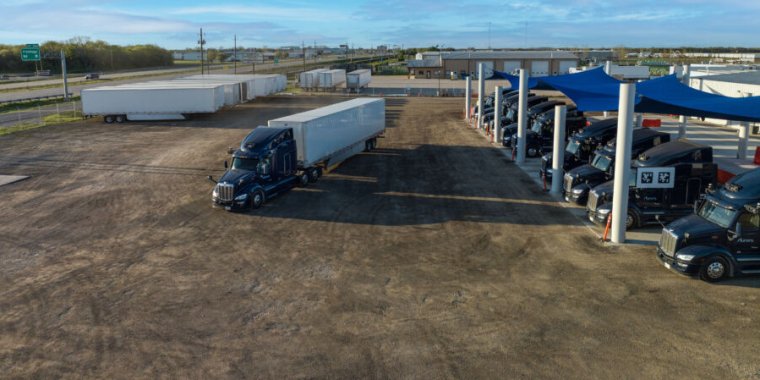Aurora
On a sunny morning in December, an 18-wheeler will pull into a truck depot in Palmer, Texas, just south of Dallas. The driver will step out of the cab and help transfer his trailer to a second rig outfitted with powerful sensors.
This second truck will head south on Interstate 45 toward Houston. It will move cautiously, mostly cruising in the right lane at 65 mph despite the 75 mph speed limit.
After three and a half hours, the truck will exit the freeway in Greenpoint, a neighborhood in the north of Houston. It will proceed to a second truck depot, where the trailer will again be transferred to a new rig. A different driver will get in and haul the cargo to its final destination a few miles away.
Trucks travel the 200 miles between Dallas and Houston all the time. But there will be something special about the middle leg of this trip: There will be no one in the vehicle.
A startup called Aurora has spent seven years—and hundreds of millions of dollars—preparing for this driverless trip, which it hopes to complete before the end of the year. Last month, I met with Aurora cofounder Sterling Anderson at the company’s office in Mountain View, California.
The office has glass-walled conference rooms and row after row of workstations. But it also has some things you won’t find at a typical Silicon Valley startup.
Anderson showed me a lab with machines to measure how well Aurora’s hardware copes with the temperature swings and vibrations it will experience on the highway. One machine shakes so hard that it needs a separate foundation to prevent it from damaging the building.
In another lab, engineers were using silicon photonics to reduce the size and cost—and increase the reliability—of Aurora’s proprietary lidar sensors.
There was a garage with several Aurora trucks. Anderson pointed out that each truck had not one but two computers tucked behind the driver’s seat. Each computer had its own power and network connections, so if one computer failed, the other could take over automatically.
“In a self-driving truck you no longer have the backup of a human,” Anderson told me. “So you have to make changes to the actuation architecture: steering actuators, braking actuators, and power architecture. You have to introduce redundancies on a number of different channels.”
“You can’t have a single point of failure,” he said. “The changes required to the base truck go very, very deep.”
The stakes are high. If Aurora’s first driverless trip down I-45 goes well, there will be dozens, then hundreds and eventually thousands, of trips like it. With hundreds of thousands of long-haul truck drivers in the United States alone, this is a huge and potentially lucrative market.
Large trucks are involved in thousands of fatal crashes every year in the United States, and driverless technology has the potential to prevent many of these crashes. But there’s also a risk that an Aurora truck could crash. A fully loaded semi-truck weighs up to 40 tons, so if Aurora’s hardware or software malfunctions, the results could be deadly.
I’m impressed by how hard Aurora has worked to prepare for fully driverless operation. But I won’t be fully convinced of Aurora’s approach until driverless trips become a daily occurrence.
After all, there used to be many more startups working on self-driving trucks, including Embark, Starsky, Ike, and TuSimple. Most of these companies ran out of money before they could demonstrate their commercial viability.
That’s not an immediate worry for Aurora, which just raised $483 million, extending its runway into 2026. And a few other driverless trucking startups are very much still in business:
- Kodiak has signed contracts with industrial and military customers to help keep the lights on while it perfects its driverless technology for long-haul trucking.
- Gatik is developing driverless box trucks to carry merchandise on shorter trips from distribution centers to retail locations for customers like Walmart and Kroger.
As we’ll see, both of these companies have already begun driverless testing in carefully limited circumstances. In the coming years, all three companies will need to scale up their driverless fleets and reach profitability—all without compromising on safety.
Source link
